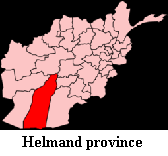 Most readers have undoubtedly heard about the children alleged to have been killed by Canadian weaponry in Kandahar, resulting in another "Death to Canada" protest. Below is some of the better reporting on that incident, which reveals that, quite apart from the merits of the recent allegations, Canadian forces have been menacing the area for some time.
Most readers have undoubtedly heard about the children alleged to have been killed by Canadian weaponry in Kandahar, resulting in another "Death to Canada" protest. Below is some of the better reporting on that incident, which reveals that, quite apart from the merits of the recent allegations, Canadian forces have been menacing the area for some time.
Graeme Smith:
Canadians blamed for childrens' deaths in Kandahar
Graeme Smith - Globe and Mail
KANDAHAR, Feb 24 - Angry villagers carted the bodies of two dead children into Kandahar city yesterday, screaming, "Death to the Canadians," and blaming the foreign troops for testing weapons near their homes...
The Canadian military has launched an investigation, saying its troops had been test-firing artillery and tank cannons...
No clear answers have emerged [as to what killed the children], said Canadian military spokesman Major Mario Couture, because that dusty part of the Panjwai valley is strewn with hazards.
"It's littered with all kinds of unexploded ordnance and mines, and it's a very dangerous area, so anything is possible," Major Couture said.
The tragedy occurred ... less than half a kilometre from Sheik Mohammed bin Rashid village, also known as the "handicapped village." It's a small settlement devoted to helping disabled Afghans, named after its benefactor** - the wealthy ruler of Dubai - whose support has been crucial for the Afghan mission...
Major Couture acknowledged that "children would have been killed and injured" had they come into contact with unexploded ordnance left behind by Canadian troops, "who were conducting a range in the area the day prior to the incident."...
Villagers were so upset by the incident that they briefly blocked two roads. At one point, they loaded the corpses of the two boys onto a wooden trailer hauled by a motorbike and drove them to the centre of Kandahar, demonstrating noisily on the road between the governor's meeting hall and the provincial council offices.
Their shouts drew the attention of journalists, whose footage showed the children's blood-splattered faces and brown eyes staring blankly...
Some of the protesters were hobbling on crutches, missing legs. Afghan officials said the dead children were residents of the so-called handicapped village... (link)
The CBC:
3rd child dies after Afghan explosion
CBC - February 24, 200
... Officials in Kandahar City's Mirwais Hospital identified the third victim as four-year-old Juma Gul, one of three children treated for shrapnel wounds after the explosion on Sunday.
Two other children, a 13-year-old identified as Sadar Walli and 12-year-old Amed Jan, were killed instantly...
But some of the village elders could not back up the father's claims.
Mohammed Zahir said he heard an explosion around 11 a.m. as children were returning from religious school...
He said foreign troops come to the area twice a month to practise firing.
"It scares our children," he said. "They can’t sleep." ... (link)
So, from all this we have established that the Canadian Forces twice monthly fires off weapons such as artillery and tank cannons in an area which has an abundance of dangerous unexploded mines and ordnance and which is located less than 500m from a village of disabled people and closer still to the village of Salehan, where the children are frightened and cannot sleep.
The third dead child would mark, by my count, the fourteenth Afghan civilian known to have been killed by Canadian troops. (See
here for antecedents.)
** Numerous reports have asserted that Sheik Muhammed (who was then crown prince) visited Osama Bin Laden in Kandahar in the late 1990's for one of Bin Laden's fund-raising hunting expeditions. (See
this L.A. Times article. ) Some insist that the sheik did not meet with Bin Laden there, or even that he did not visit Kandahar at all at that time. However, the existence of a charity village dedicated to the sheik is perhaps support for the assertion that he has visited the area.
N.B.: For more on the Oct 18 2006 incident in Ashoqa (aka Ashogo) noted in the graphic above, see Markland,
"Media blind to Afghan civilian deaths".
February's toll:February 5-6: US-led coalition forces in Zabul kill 6 civilians in an attack which targeted insurgents, say Afghan officials.
February 6: US-led
coalition forces shoot and kill one man and wound a woman and child at a checkpoint in Khost province.
February 11: A provincial spokesman says
NATO airstrikes kill four civilians in Logar province.
February 12: Five children are killed as Australian special forces battle militants while searching a house in Uruzgan province.
February 16: In Herat
US forces kill 12 - 16 civilians in air attacks. An American investigation claims that 13 civilians and three militants were killed.
February 17: Two civilians in a vehicle are killed by NATO-led troops on patrol in the Maywand district of Kandahar.
February 23: Villagers report that Canadian weaponry killed three children in Panjwai district. According to some, it was unexploded left-over ordnance; others said it was a Canadian artillery shell fired at the children.
comfortably with elders, it feels surreal, confining and terribly sad to return in a veritable tank -- peering through bullet-proof glass at a once-familiar landscape, drawing sullen stares from people who once smiled and invited curious foreigners in for tea.















